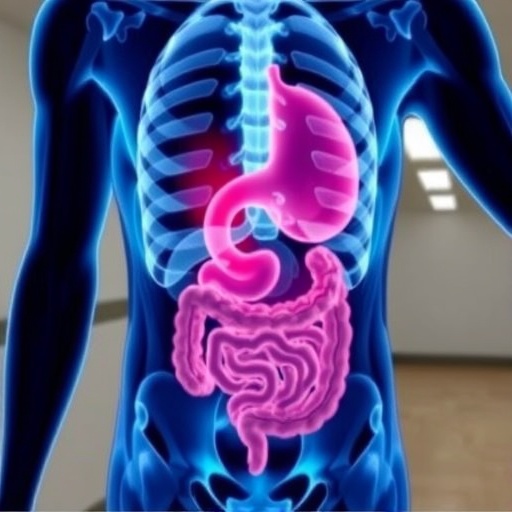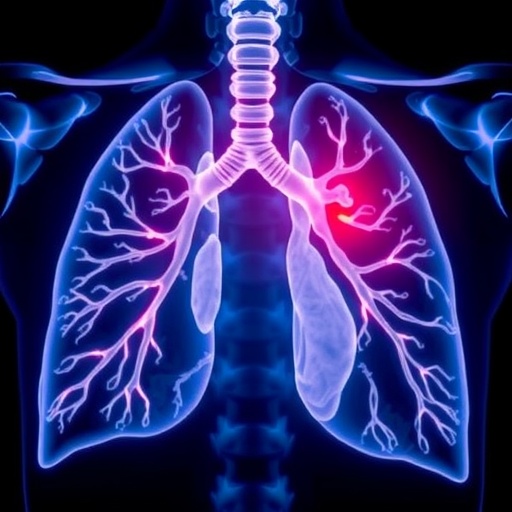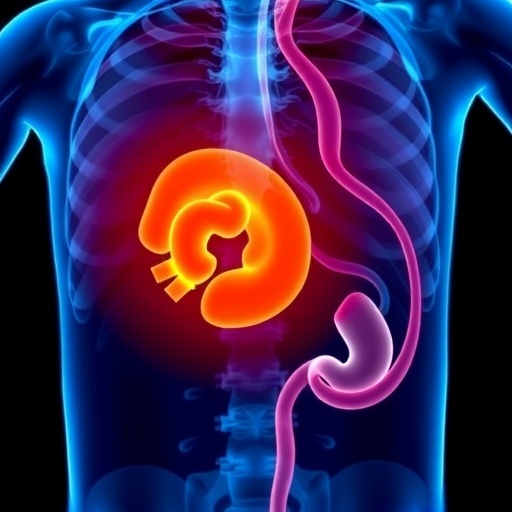In a significant advancement for prostate cancer treatment, the Phase III clinical trial NRG-GU005 has shed new light on the comparative effectiveness of stereotactic body radiation therapy (SBRT) versus moderately hypofractionated intensity-modulated radiation therapy (MH-IMRT) for patients diagnosed with localized intermediate-risk prostate cancer. Recent results from this landmark study reveal that SBRT not only preserves but improves bowel health-related quality of life (HRQOL) relative to MH-IMRT, marking a pivotal development in the therapeutic landscape for this patient population.
This multi-institutional trial enrolled 698 evaluable participants, randomly assigning them to either a regimen of SBRT at a dose of 36.25 Gy delivered in 5 fractions or to MH-IMRT administered either as 70 Gy in 28 fractions or 60 Gy in 20 fractions. The core objective was to evaluate patient-reported outcomes using the expanded Prostate Cancer Index Composite (EPIC-26) questionnaire, specifically focusing on the bowel and urinary irritation or obstruction domains at baseline, 12 months, and 24 months post-treatment. By assessing minimal clinically important decline (MCID), the study meticulously quantified nuanced changes in quality of life.
The EPIC-26 tool, a validated patient-reported outcome measure, enables quantification of symptoms impacting quality of life that are crucial for patients with prostate cancer, particularly in areas like bowel function and urinary control that often bear the brunt of radiation-induced toxicity. At the two-year mark post-treatment, the data demonstrated a statistically significant reduction in bowel-related MCID in patients treated with SBRT compared to those receiving MH-IMRT—34.9% versus 43.8% respectively, with a p-value of 0.034. This evidence implies a tangible benefit of SBRT in mitigating late bowel toxicity, a common and distressing side effect that compromises patients’ well-being.
Importantly, the trial also explored urinary health outcomes, analyzing the frequency of minimal clinically important declines related to urinary irritative or obstructive symptoms. Contrary to the bowel domain observations, urinary symptom rates did not differ significantly between SBRT and MH-IMRT groups, with respective MCID frequencies of 33.7% versus 34.7% (p=0.68). Despite this, secondary genitourinary metrics, including incontinence-related quality of life and erectile function maintenance, showed favorable trends with SBRT, highlighting its nuanced advantages in functional outcomes beyond primary endpoints.
Beyond quality-of-life measures, one of the pivotal co-primary endpoints was disease-free survival (DFS). The interim results of the study revealed that SBRT did not demonstrate superiority over hypofractionated IMRT in extending DFS at the three-year follow-up, with this co-primary endpoint crossing futility boundaries due to a higher rate of biochemical failure determined by prostate-specific antigen (PSA) levels in the SBRT arm. While this finding tempers expectations regarding SBRT’s oncologic superiority, it accentuates the necessity for prolonged follow-up to ascertain long-term efficacy beyond the current timeframe.
The trial’s findings dovetail with prior research, such as the PACE-B study, which established the non-inferiority of SBRT compared to conventional IMRT protocols. However, NRG-GU005 distinguishes itself by emphasizing patient-reported outcomes, underscoring the principle that therapeutic regimens must not only aim for tumor control but must also prioritize the preservation of patients’ quality of life during survivorship—a factor of immense importance in localized prostate cancer management where survival outcomes are generally favorable.
Notably, the improved bowel health outcomes observed with SBRT may be attributed to its precise, high-dose, hypofractionated delivery that minimizes radiation exposure to surrounding rectal tissues. Additionally, the use of rectal spacers during SBRT procedures further enhances tissue sparing, contributing to favorable quality-of-life metrics and affirming technical refinements’ role in optimizing radiation therapy’s therapeutic ratio.
The rigorous design of NRG-GU005 included serial administrations of EPIC-26 at critical intervals, securing high compliance rates—82.5% for MH-IMRT and 85.1% for SBRT at two years post-treatment. This robust data collection strengthens the confidence in these findings and provides a comprehensive picture of treatment-associated morbidity in a real-world clinical context. EPIC-26’s dual-domain evaluation of bowel and urinary health offers nuanced insights into subclinical and clinical symptom trajectories over time.
As Dr. Rodney J. Ellis from the University of South Florida, lead author of the NRG-GU005 abstract, noted, the trial’s findings substantiate SBRT as a compelling option that balances oncologic outcomes with patient-centered quality-of-life gains. While urinary irritation or obstruction did not significantly improve, the favorable secondary genitourinary endpoints suggest SBRT’s potential in mitigating other dimensions of treatment-related morbidity.
Equally crucial is the trial’s spotlight on the evolving paradigm of radiation fractionation in prostate cancer. Hypofractionated regimens like SBRT deliver a larger dose per fraction over fewer treatment sessions, offering logistical advantages such as reduced overall treatment time and improved resource utilization, which are increasingly relevant in busy oncology practices and for patient convenience.
Nonetheless, the absence of clear DFS superiority calls for cautious interpretation. While early biochemical recurrence may be higher, long-term oncologic outcomes remain the gold standard for treatment evaluation. Therefore, sustained longitudinal follow-up is imperative to fully characterize the risk-benefit balance and to ascertain whether the quality-of-life gains with SBRT can be maintained without compromising cancer control.
In light of these findings, clinical decision-making for localized intermediate-risk prostate cancer should integrate patient preferences, treatment logistics, potential side effect profiles, and long-term oncologic considerations. NRG-GU005 enriches the evidence base supporting SBRT as a viable and potentially preferred treatment option, especially for patients prioritizing bowel health and overall quality of life without sacrificing efficacy.
Funding for NRG-GU005 was robust, sourced from several National Cancer Institute grants, reflecting the collaborative effort between the NRG Oncology research network and federal agencies committed to advancing prostate cancer therapeutics. This level of investment underscores the critical importance placed on refining radiation modalities to optimize outcomes for patients worldwide.
The broader implications of this study resonate profoundly within clinical oncology, as the balance between treatment efficacy and quality of life becomes increasingly central to therapeutic strategies. NRG-GU005’s findings are expected to influence clinical guidelines, radiation oncology practices, and patient consultations, fostering a more nuanced, patient-centric approach to prostate cancer treatment in the modern era.
For those eager to delve deeper, a special episode of the NRG Oncology Podcast features an in-depth discussion with Dr. Rodney Ellis on the trial’s results and their clinical significance. Available across platforms such as Spotify, Apple Podcasts, and YouTube, this podcast serves as a valuable educational resource for clinicians, researchers, and patients alike.
In summary, the NRG-GU005 trial represents a landmark step forward in evaluating radiation strategies for intermediate-risk prostate cancer. By conclusively demonstrating that SBRT can improve bowel-related quality of life without compromising short-term disease control, this research propels SBRT into a favored position in the therapeutic armamentarium—heralding a future where precision radiation delivers not only cure but also compassionate, patient-centered care.
Subject of Research:
Localized intermediate-risk prostate cancer treatment outcomes comparing SBRT and hypofractionated IMRT.
Article Title:
Primary results from NRG-GU005: A Phase III Trial of SBRT vs. Hypofractionated IMRT for Localized Intermediate Risk Prostate Cancer.
News Publication Date:
September-October 2025.
Web References:
NRG Oncology Podcast
Spotify
Apple Podcasts
YouTube Podcast Channel
NRG Oncology Official Website
References:
Ellis RJ, Pugh SL, Yu JB, Feng FY, Konski AA, Grubb III RL, Wallace RE, Gladstone DJ, Ménard C, Frazier AJ, Pennington JD, Michalski JM, Spratt DE, Martinez A, Morgan SC, Mihai A, Paulus R, Sander HM. Primary results from NRG-GU005: A Phase III Trial of SBRT vs. Hypofractionated IMRT for Localized Intermediate Risk Prostate Cancer. Paper presented during the Plenary Session at the American Society for Radiation Oncology Annual Meeting, San Francisco, CA, 2025.
Keywords:
Prostate cancer, stereotactic body radiation therapy, hypofractionated intensity-modulated radiation therapy, radiation therapy, quality of life, patient-reported outcomes, EPIC-26, bowel health, urinary symptoms, disease-free survival, clinical trial, NRG-GU005, radiation oncology.
Tags: bowel health quality of lifeEPIC-26 questionnaire usehypofractionated radiation therapy comparisonlocalized intermediate-risk prostate cancermulti-institutional clinical researchNRG Oncology trial resultspatient-reported outcomes in oncologyphase III clinical trial findingsprostate cancer treatmentquality of life measurement in cancer patientsradiation therapy side effectsstereotactic body radiation therapy benefits





